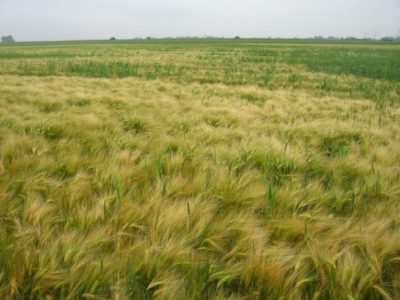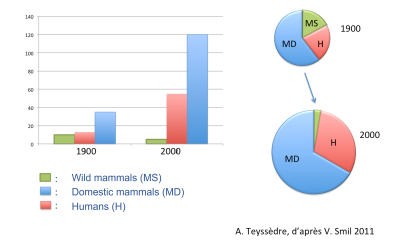Impacts of agriculture on the proportions of wild and domestic species
PDFSchematically, the expansion and especially the intensification of agriculture can be seen as a reorientation of ecological networks towards the massive production of a few cultivated or domesticated plant and animal species, primarily provided for human consumption. One of the effects of agriculture is then to reduce the share of wild species in biodiversity, in biomass.
Estimates of the impact of agriculture on the world’s animal and plant biomass are difficult to quantify over long periods of time and on all continents, and vary greatly depending on the group considered.

For terrestrial mammals and birds, whose biomasses are much lower than those of plants, the picture is different. Overall, on a global scale, the detour of ecological networks towards the production of a minority of ‘domesticated’ animal and plant species, for food and other human uses, has both:
- reduced the abundance (see above) and biomass of wild species, mainly through ‘conversion’, fragmentation and transformation/pollution of their habitats;
- increased -from zero- the biomass of domesticated mammals and birds, by artificial selection and breeding of ‘agricultural’ species in modified ecosystems;
- increased the total biomass of mammals and birds, at the expense of other groups of heterotrophic organisms such as insects, amphibians, annelids and fungi.
Thus, it can be estimated that the loss -in number of individuals- of 30% of land birds (as opposed to seabirds), linked to the expansion and intensification of agriculture since its beginnings [2], has reduced the total biomass of wild birds by about 20%, estimated today at two million tons of Carbon (Mt C). During the same period, but especially since the invention of intensive livestock farming in the USA (in the 1930s) and its diffusion in Europe and elsewhere after World War II, the biomass of chickens and other “backyard” birds has increased to reach today 5 Mt C, i.e. nearly 3 times that of wild birds [3].

Agriculture thus has two opposing effects on the dynamics of mammals and birds, on a global scale: it increases their total biomass while reducing their diversity in number of species (and genes). As for the abundance of populations and communities, in number of individuals, it decreases on average for wild species but increases for domestic species, with monospecific agricultural communities.
It should be noted here that the “benefit” of the growth in biomass of domesticated mammals and birds, relative to wild species, is purely numerical. It concerns groups of living beings, and can be applied to the productivity of ecosystems, but does not regard individual animals and their well-being. On the contrary! The current practices of intensive breeding that have allowed these increases in biomass have considerably degraded the living conditions of chickens, calves, pigs and other domestic animals, confined in so-called “agricultural” buildings from from birth to death. (see https://www.ciwf.fr/ressources/).
Notes and references
Cover image. From figure 1 cropped, royalty free.
[1] Erb K-H et al. 2017. Unexpectedly large impact of forest management and grazing on global vegetation biomass. Nature 553:73-76.
[2] Gaston K.J., Tim M. Blackburn & Kees Klein Goldewijk, 2003. Habitat conversion and global avian biodiversity loss. Proc. R. Soc. Lond. B 270, 1293-1300. DOI 10.1098/rspb.2002.2303.
[3] Bar-On Y.M., R. Phillips & R. Milo, 2018. The biomass distribution on Earth. P.N.A.S. 115: 6506-6511.
[4] Smil V., 2011. Harvesting the Biosphere: The Human Impact. Pop. Dev. Rev. 37(4): 613-636.





